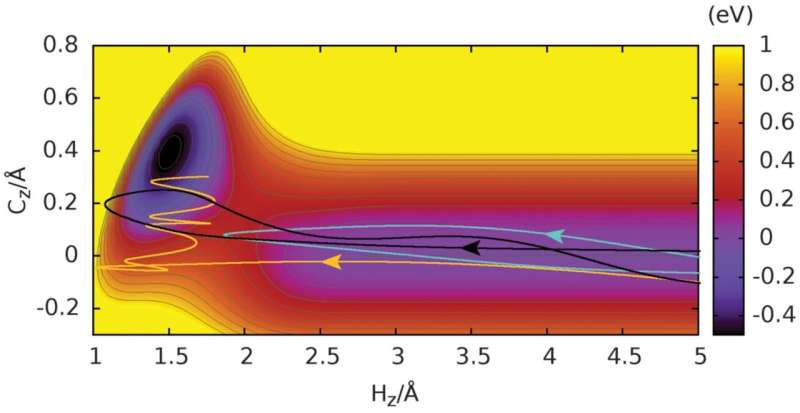April 26, 2019 report
Researchers find H-C bonds form when hydrogen atoms collide at high speed with graphene

A team of researchers from Germany, the U.S. and the U.K. has found that a significant number of H-C bonds formed when hydrogen atoms were forced at high speed to collide with graphene. In their paper published in the journal Science, the researchers describe their efforts to view the atomic-scale motion that occurs and the energy dissipation pathways that are involved when covalent bonds form—in this case between a carbon atom and a hydrogen atom as it smashes into a sheet of graphene. Liv Hornekær with iNANO has published a Perspective piece on the work done by the team in the same journal issue.
The researchers note that despite a lot of effort, very few ways have been found to actually see what happens at the atomic scale as a covalent bond is forming. In this new effort, they sought to find a new way to see what happens using hydrogen atoms and graphene. They point out that for a covalent bond to form between colliding molecules, energy must flow from them into the rest of the molecules in a given system. To that end, the researchers fired hydrogen atoms at high speed at a sheet of graphene that was sitting on a plate made of platinum. They chose graphene because it has extreme asymmetry (an attribute that makes it one of the few materials that contract when heated). They then closely monitored and measured what happened as the hydrogen atom struck.
The researchers report that the collision between the hydrogen atom and graphene sheet resulted in the creation of bonds between the hydrogen atom and carbon atoms in the graphene. They further report that energy was very efficiently dissipated by an in-plane sonic wave that formed moving along the length of the sheet of graphene. They also found that a transverse wave was also formed that supported out of plane vibrations—it was formed by displacement of carbon atoms as they interacted with the hydrogen atom. The team also reports that the H-C bonds that formed were strong enough to allow many of the hydrogen atoms to actually stick to the graphene sheet rather than bounce off of it. They also claim that their experiments have revealed a previously unknown pathway to energy loss in a system where covalent bonds are formed, opening up new ways to study the process as it occurs.
More information: Hongyan Jiang et al. Imaging covalent bond formation by H atom scattering from graphene, Science (2019). DOI: 10.1126/science.aaw6378
Liv Hornekær. Stabilizing a C–H bond on graphene with sound, Science (2019). DOI: 10.1126/science.aax1980
Journal information: Science
© 2019 Science X Network





















